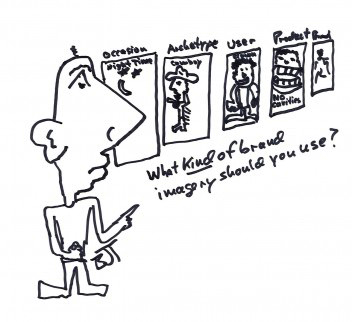
Selecting the type of brand imagery driving your brand should be done consciously.
The first step in defining a differentiated Strategic POV or positioning for a brand should be determining the type of brand imagery you want to use in your positioning. We have built on the work of Wendy Gordon to create different classes of brand imagery. A given Strategic POV will generally be built around one or two types of brand imagery. And we often find that all the brands in a category are using the same type of brand imagery to position their brands. That’s an opportunity to differentiate. Selecting a different class of brand imagery will allow you to stand apart. Therefore, thinking about the kind of brand imagery you want to use in a careful, systematic way can change the vocabulary in your category and fundamentally differentiate your brand.
Let’s look at the different classes of brand imagery:
– Product Imagery (What functional product performance characteristics do we want to associate with this brand? Volvo used this for years to become known as “safe.”)
– User Imagery (What kind of person do we want to associate with this brand? Louis Vuitton uses globally recognizable, established/accomplished agents of change like Gorbachev and Keith Richards to signify the type of person or “badge” they want associated with their brand.)
– Occasion Imagery (What kind of occasion do we want to associate with this brand? Corona has become synonymous with relaxing in the U.S. and Kit Kat is the snack for a break in a hectic day.)
– Archetype Imagery (What kind of personality traits do we want to associate with this brand? Bud Light has a certain frat-boy sense of humor that fits well with its target group. It could be seen as the “Jester” archetype. We try to align a brand with particular, focused archetype rather than list a lot of personality terms that are often schizophrenic and useless when executing.)
– Proximity Imagery (How do we remind consumers of the great times and relationship they have with this brand? Brands like Coke and McDonald’s can reference birthday parties and first dates as ways to remind people how the brand is part of their personal history.)
– Values Imagery (What does this brand believe in? What is it’s philosophy for living? When Nike says “Just Do It” they are espousing a way of living your life. It demonstrates the values they hold dear.)
It is very common for a category to become fixated on one of these forms of brand imagery, with all the brands in the category using slightly different shades of that same type of imagery. For instance, the beer category was for years built on Archetype Imagery and User Imagery. To stand out in this context, Corona decided to consciously avoid showing a type of person as their drinker. The commercials showed the backs of people on the beach, enjoying a laid back relaxing moment. They used Occasion Imagery to differentiate themselves. In effect, they were changing the vocabulary of the category and it worked to drive share gains for years.
In research, it’s easy to use projective techniques to understand how consumers view the brand imagery for each brand. Then we have them imagine the “ideal brand” in the category. Often the “ideal” is described using imagery that is not used very much in the category. This is a huge opportunity. We saw this in the blue jeans category when working on Lee Jeans. At that time the category was all about Product Imagery — how you would look in the jeans — and User Imagery — who wears the brand. We saw that the “ideal brand” would provide confidence that actually changes behavior. It would allow (young men in this case) to escape being a poser and act on their beliefs and values. This ideal brand was more about Archetype Imagery (a man of action) and Values Imagery (doing the right thing rather than conforming). We re-positioned Lee using a Strategic POV that played to the imagery of the ideal brand. The results were spectacular with younger male share going from 2% to over 20% in stores where Lee Jeans were sold.
Differentiation is hard. Most studies show that brands are failing on this front. But it’s all that stands between a brand and a commodity. By looking for different types of imagery as your lever, you can move into fresh, original space that is highly relevant to the consumer. You can fundamentally change the vocabulary and the conversation in your brand’s favor.


0 Comments
Comments are open. Leave one using the form below.